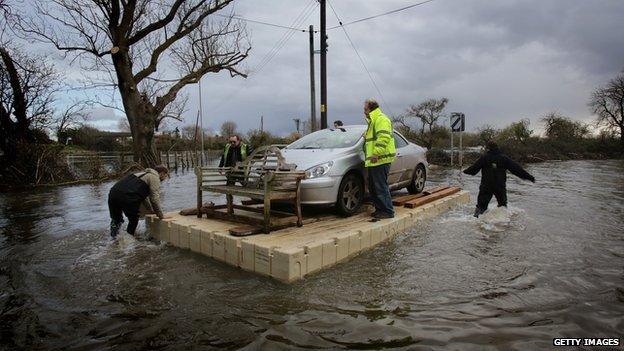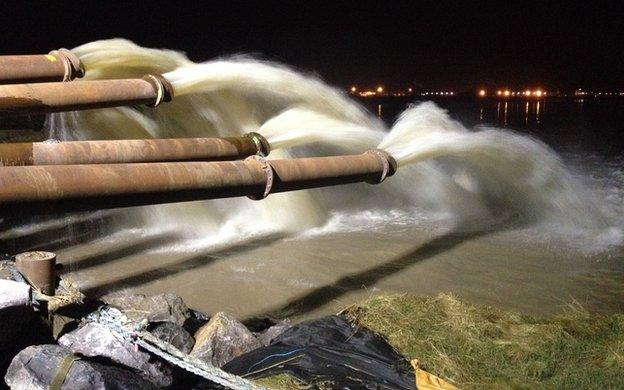Costly plan to reduce Somerset floods
- Published
- comments

Local people have argued that floods are exacerbated by silt clogging up rivers
Efforts to help one of Britain's most flood-prone regions will cost "tens of millions of pounds", according to the Environment Agency.
A plan to safeguard the Somerset Levels is due to be unveiled tomorrow amid concerns about the funding needed to implement it.
Parts of the area have been underwater for more than two months with many homes, roads and farms still affected.
The flooding led to intense criticism of the Environment Agency last month which in turn triggered an open dispute at senior levels of government.
One immediate measure, already announced, is a scheme to clear a five-mile stretch of waterway where two key rivers meet.
Computer modelling of that proposal shows that dredging could reduce the height of flooding and its duration.
Local people have long demanded dredging of this kind, arguing that the floods have been exacerbated by silt clogging the rivers.
Further steps are expected to include installing bigger pumps and providing better protection for villages.
A long-standing proposal to build a new barrier to hold back high tides may also be brought forward.
In a winter of extreme weather, the sheer duration of the floods in the Somerset Levels has made the plight of this area highly sensitive politically.
Agreed strategy
The plan comes after the Environment Secretary Owen Paterson visited Somerset and called on local organisations to pull together an agreed strategy within six weeks.
The government has already promised an extra £10m to assist the area but there are questions about how much extra cash will be available beyond that.

This graphic shows computer modelling of a 2012 flood in Somerset versus what might have happened with dredging
The plan is designed to offer a comprehensive solution for the area ranging from encouraging farmers to retain rainwater in the uplands to improving the flow of water through the Levels themselves to helping local people make their communities more resilient.
One major cost already accounted for is £4.1m for the dredging operation along the rivers Parrett and Tone.
But officials estimate that a proposal to upgrade an artificial river, the Sowy, could cost £4m-£8m and the plan for a tidal barrier at Bridgwater - to keep the highest tides out of the River Parrett - was priced at nearly £25m back in 2009 and is understood to be higher now.
David Rooke, head of flood risk management at the Environment Agency, refused to put a price tag on the overall cost of the proposals.
But, in a BBC interview, he said: "It would be tens of millions and it would need to be sustained for the next 10-20 years."
"You're certainly talking a lot of money both from central government and local government and keeping that funding in place for many years."
Estimating benefits
Mr Rooke also warned that if the Somerset Levels were protected to a far higher standard, other areas may demand the same level of defence too - and current funding will not cover that.
"To avoid the sort of extreme event that we've seen, if we replicated that standard right across the country you'd be talking many billions of investment to give people the same standard of protection and at the moment government policy is not to do that."
Another official, speaking privately, said the assumption was that any plans to spend more than the £10m already agreed in Somerset would have to be settled in the usual competitive way.

Pumps installed near Bridgwater spew out 16 tonnes of water each second
That involves officials estimating the benefits of any scheme in terms of economic gain or households protected - and until recently, the Somerset Levels have fared badly in that calculation.
The plan to start dredging has been assessed in detail by flood risk specialists from the consultancy Black & Veatch.
Principal engineer Andy Wallis, who has long experience of the Somerset Levels, said research into an earlier flood in the same area in the winter of 2012 showed that dredging could bring benefits.
"Flooding is all about risk and you can never eliminate risk but you can very much reduce the risk and what dredging does is reduce the volume of water ending up in these areas.
"We know the current event is more extreme than last year and we know that dredging in this area would have had a benefit - it certainly wouldn't have eliminated flooding but it would have affected the duration of the event."
Other measures beyond dredging will need to be studied in more detail before being approved.